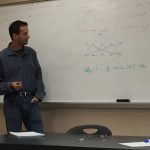 Sorting Index and Mahonian-Stirling pairs for labeled forests
Sorting Index and Mahonian-Stirling pairs for labeled forests
Björner and Wachs defined a major index for labeled plane forests and showed that it has the same distribution as the number of inversions. We will define and study the distributions of a few other natural statistics on labeled forests. Specifically, we introduce the notions of bottom-to-top maxima, cyclic bottom-to-top maxima, sorting index and cycle minima. Then we show that the pairs (inv, Btmax), (sor, Cyc), and (maj, Cbtmax) are equidistributed. Our results extend the result of Bj¨orner and Wachs and generalize results for permutations.
 Properties of the Promotion Markov Chain on Linear Extensions
Properties of the Promotion Markov Chain on Linear Extensions
The Tsetlin library is a model for the way an arrangement of books on a library shelf evolves over time. It assumes that, given n books, one book is read and returned at the end of the shelf before another one is picked up. Suppose the probability that a book i is picked up is x_i. An interesting property of this Markov chain is that its eigenvalues can be computed exactly and they are linear in the x_i ‘s. This result has been generalized in various ways by various people. In this work, we investigate the extended promotion Markov Chain introduced by Ayyer, Klee, and Schilling in 2014. They showed that for a poset that is a rooted forest, the transition matrix has eigenvalues that are linear in x_1,…, x_n. We show the same result for a larger class of posets.
 Lattice Cryptography and Attacks
Lattice Cryptography and Attacks






